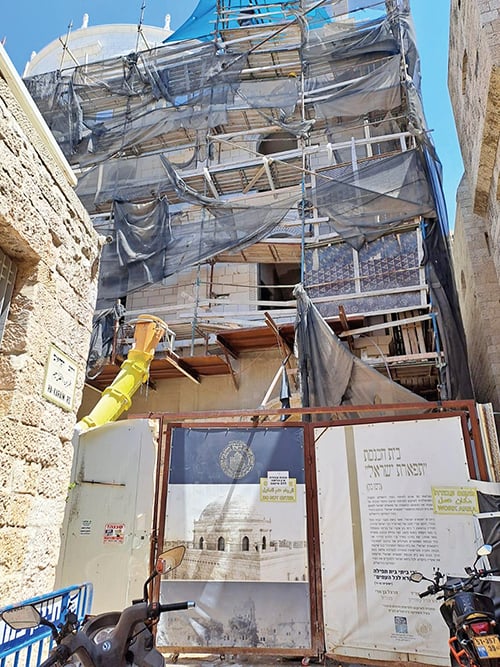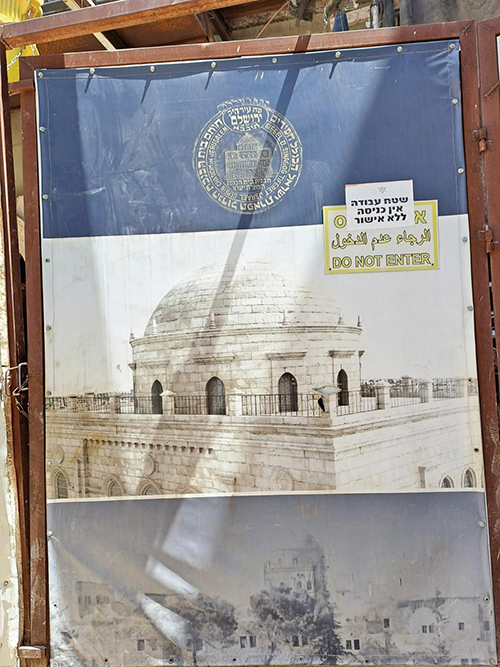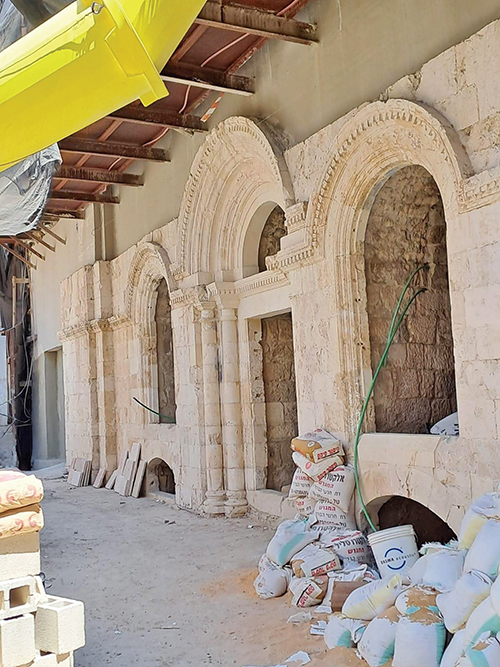
(Most of the information for this article was culled from “הרובע היהודי וכל נתיבותיו” by Eyal Davidson, as well as a lecture for guides from Dr. Oren Goltfeld run by the Western Wall Heritage Foundation.)
Many of you may be familiar with the Churva synagogue that stands proudly in the Jewish quarter of Yerushalayim’s Old City. But did you know that the Churva Synagogue has a Chasidishe twin? Let me introduce you to the Tiferes Yisroel Synagogue.
Rav Yisrael Friedman, the Admor of Ruzhin in the mid-1800s, was well known for his love of Eretz Yisroel and encouragement of his Chasidim to move there. When Nissan Bek, one of his primary Chasidim, informed him that the Russian czar planned to buy land in the Jewish quarter of Yerushalayim (in order to build a church, the Ruzhinner Rebbe instructed him to return to Eretz Yisroel, pre-empt the czar and buy the land at any cost. Bek was successful in his mission and recorded completing his purchase of the plot in 1943.
There were still a lot of political and financial obstacles that needed to be overcome before construction of the synagogue could be completed. Political ties were contacted and with the help of the Baron de Rothschild, permission was granted from the Ottoman authorities to construct a new synagogue.
By this time Rav Yisroel Friedman had passed away and his son, Rav Avraham Yaakov, who inherited his father’s court and became known as the Admor of Sadigura, continued to support the building in Yerushalayim. The Chasidish community of Yerushalayim grew, but due to lack of resources, the building of their new synagogue progressed slowly. In the meantime, the Litvish Ashkenazim completed their building of the Churva Synagogue, which now stood proudly in the Old City and further inspired the Chasidim to complete the building of their own.

In 1869, the Austrian-Hungarian kaiser, Franz Joseph, came to visit Jerusalem and was accorded great honor by the Jewish community. He was very impressed by the building of the new synagogue, and legend tells that he inquired as to why the building was missing its dome. Bek responded that the synagogue had removed its hat in honor of the kaiser. The kaiser was so impressed by his response that he gave a generous donation towards the building of the synagogue. In fact, though, it was the Admor of Sadigura who donated a very generous sum to complete building the dome of the synagogue. He was aided by the Sassoon family, who also contributed generously.
The synagogue was finally completed in 1872 and was named the Tiferes Yisroel Synagogue in honor of the Rebbe Yisroel of Ruzhin, who initiated its construction. Colloquially, though, it was called “Nissan’s shul” in Yiddish, in honor of Nissan Bek. The synagogue was the tallest building in the Old City and its dome towered above the Dome of the Rock on Har HaBayit, which of course awakened the envy of the Muslims. To make matters worse, the dome was originally painted green, which is a symbolic color in Islam. The green dome was soon repainted white in order to calm things down a little.
The Tiferes Yisroel Synagogue did not only house prayer services. It also had a small room dedicated for hospitality. In its basement were mikvaot as well as large water cisterns.
In Israel’s War of Independence in 1948, the roof of the synagogue was an important strategic location, and battles for control of it raged between the Arab legions and the Jewish defendants of the Jewish Quarter. Ultimately, it was blown up by the Arab legions, its dome collapsed, and the synagogue was left in ruins. The Ruzhiner Chasidim built a new center in Geulah on Malchei Yisroel Street.
In 1985, the Israeli government authorized the rebuilding of the Tiferes Yisroel Synagogue, which is currently on the verge of completion. The building is being rebuilt in keeping with its original style and design, available from photographs of the early 20th century. All that is being added is an elevator and air conditioning.
Prior to building in the Jewish Quarter, new areas are first excavated by archeologists. I was privileged to attend a lecture by Dr. Oren Goltfeld, the archeologist who excavated underneath the ruins of the Tiferes Yisroel Synagogue. He described the treasures that were found there from the time of the First Beit Hamikdash until today. Most notable was a stone weight with the inscription (נדברי קטרס) similar to the one found nearby in the Burnt House. The Katros family of Kohanim is mentioned in the Talmud (פסחים נ”ז.). A treasury of ancient coins from the fourth year of the rebellion against the Romans was also found there. A thick layer of ash covers the finds from the time of the second Beit Hamikdash, a real physical remnant of the churban (destruction.) The finds will be displayed in the basement of the Tiferes Yisroel Synagogue once it becomes open to the public.

Hopefully soon, we will be able to visit the Tiferes Yisroel Synagogue, enjoy the impressive view from its rooftop and explore the fascinating archeological remains in its basement.
Hava Preil is an enthusiastic licensed Israeli tour guide. She grew up on the Upper West Side of Manhattan and holds an MA in Judaic studies. Hava has developed and taught accredited courses in Tanach and Jewish ethics for Naaleh/Woodmont College and Cybersem. She currently lives in Givat Ze’ev, Israel with her family. Hava can be reached at IL: 054-844-1579, USA: 845-391-0438 or at [email protected]. Visit her new website, Havapreiltours.com












